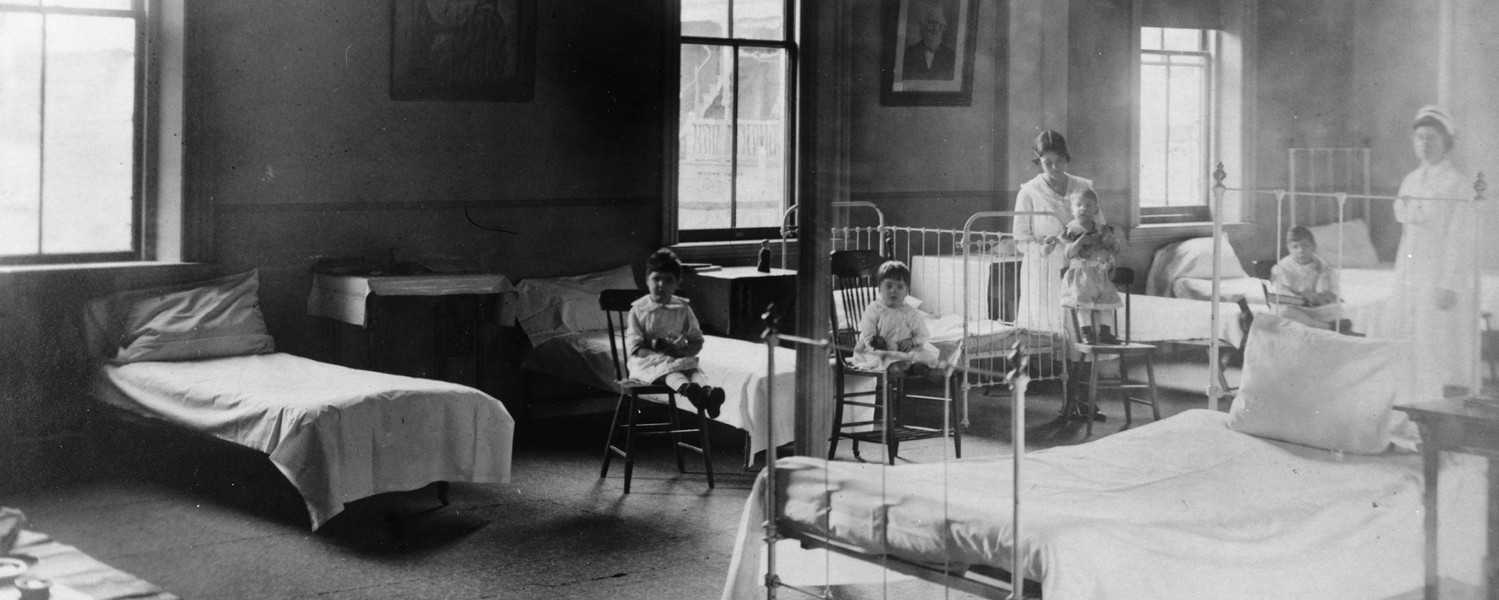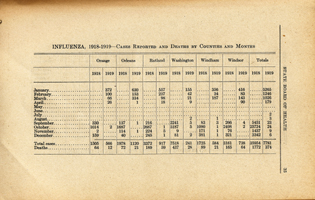The Flu Epidemic, 1918

In the late summer and autumn of 1918, the population of Vermont was ravaged by the pandemic of “Spanish Influenza” that struck nationwide and worldwide. The disease, which attacked the lungs, caused high fever, delirium, excruciating pains in the back and limbs, and nausea, swept across the state rapidly.
Oral history transcriptions
Click a name below for more information. All transcripts are in PDF format.
Background information
First noted in reports coming from Fort Devens, Massachusetts, where American troops were assembled for transport to Europe to fight in World War I, the disease quickly spread into Vermont through the transportation centers of St. Johnsbury, St. Albans, White River Junction, Rutland, in the more densely populated communities of Burlington and its neighboring towns, and—most severely hit of all—Barre and Montpelier.
The disease typically ran its course in three weeks, but could kill victims in three days or less. Without the aid of antibiotics or antiviral medicines, physicians were unable to treat cases of flu or its complications, most frequently pneumonia. They were therefore reduced to making diagnoses, treating symptoms, and recording the cause of death. Newspapers carried advertisements for patent medicines, none of which was truly effective in preventing or curing the flu. Makeshift clinics were assembled in churches, libraries, and other buildings. The hospitals in Barre and Montpelier hastily constructed new wings or added a floor to accommodate the flood of patients. In Burlington, the mayor took the unusual and controversial step of opening a dispensary where flu victims with signed notes from their doctors could acquire carefully measured quantities of alcoholic beverages, thought to be a preventative medicine. A critical shortage of doctors, nurses, and medical facilities developed by mid-September, so that Vermont Governor Horace F. Graham turned down the desperate call of Massachusetts Lieutenant Governor Calvin Coolidge for doctors from Vermont. The senior class of medical students at the University of Vermont was pressed into field service; newspapers called on healthy and capable women to take on nursing duties.
By the end of September and into early October, town medical officers began exercising their authority to close all public meeting places—schools, churches, places of entertainment—and a statewide ban on public meetings went into effect on October 4. The Vermont Supreme Court, after postponing its October term several times, finally cancelled it altogether. Middlebury College was quarantined, and the University of Vermont postponed opening its autumn term.
 The flu subsided in November—just as World War I came to an end—but scattered and less severe outbreaks persisted into February 1919. Statistics reported by the Board of Health for 1918 show the devastation. In a state with a population of 355,956 in the 1910 census, there were 43,735 cases of influenza in 1918, resulting in 1,772 deaths. The disease thus attacked 13 percent of the population and accounted for 25 percent of deaths for the year. These were approximate figures only, and do not include cases and deaths from pneumonia.
The flu subsided in November—just as World War I came to an end—but scattered and less severe outbreaks persisted into February 1919. Statistics reported by the Board of Health for 1918 show the devastation. In a state with a population of 355,956 in the 1910 census, there were 43,735 cases of influenza in 1918, resulting in 1,772 deaths. The disease thus attacked 13 percent of the population and accounted for 25 percent of deaths for the year. These were approximate figures only, and do not include cases and deaths from pneumonia.
The epidemic had devastating effects on social and family life in Vermont. Because the Spanish flu had the peculiar pattern of fatally attacking people in the middle years, many children were left with one or no parents and were sent off to live with relatives elsewhere. In hard-hit communities, the deaths came so rapidly, in such great number, and under the stress of quarantine, that funeral ceremonies and interments were frequently performed unattended by mourners.
As a result of the flu, a major reform of the public health system was instituted in the 1919 General Assembly. Local Health Officers were abolished and replaced with ten sanitary and health districts. District officers were appointed by the State Board of Health and had to be certified physicians. New regulations and procedures for reporting diseases and issuing quarantine cards were imposed, and other measures were taken to give the state board more control over information about epidemics.
This reform lasted only a few years, however, and in 1923 the town reasserted their local control with a return to the local health officer system, now modified and refined by the memory of the epidemic.
—Michael Sherman
Further reading
Digital Vermont, 1918 Influenza Pandemic. (Primary sources in an online, digital archive.)
John M. Barry. The Great Influenza: The Epic Story of the Deadliest Plague in History. (New York: Penguin Books, 2005).
Alfred W. Crosby. America’s Forgotten Pandemic: The Influenza of 1918. (Cambridge [England]; New York: Cambridge University Press, 1989).
Richard Collier. The Plague of the Spanish Lady: The Influenza Pandemic of 1918-1919. (London: Macmillan, 1974).
Dorman B. E. Kent. Diary for 1918. Kent, a resident of Montpelier, Vermont, came down with flu, as did his two sons. He provides an excellent account of symptoms and the impact on the community. Vermont Historical Society library.
Gina Kolata. Flu: The Story of the Great Influenza Pandemic of 1918 and the Search for the Virus that Caused It. (New York: Farrar, Straus and Giroux, 1999).
Howard Phillips and David Killingray, eds. The Spanish Influenza Pandemic of 1918-19:New Perspectives. (London ; New York: Routledge, 2003).
Katherine Anne Porter, “Pale Horse, Pale Rider’ (1938). A short story based on autobiographical material. The author was at the time a reporter in Denver, Colorado, and was stricken with the flu.
Michael Sherman, “‘Awful, Awful’: The Spanish Flu in Vermont, 1918-1919.” Historic Roots: A Magazine of Vermont History Vol. 3, No. 1 (April 1998): 11-18.
Citation for this page
Woodsmoke Productions and Vermont Historical Society, “The Flu Epidemic, 1918,” The Green Mountain Chronicles radio broadcast and background information, original broadcast 1988-89. https://vermonthistory.org/flu-epidemic-1918